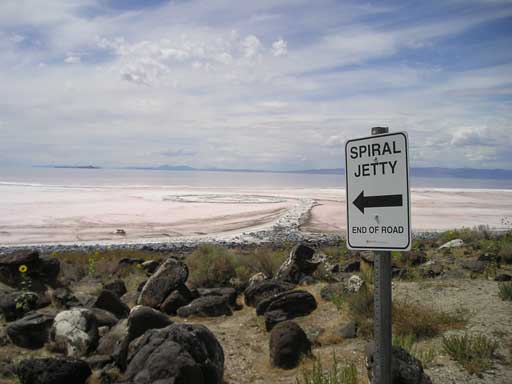#13 - Spiral Jetty

During a visit to Robert Smithson's sculpture (if that's what one should call it), a bomb exploded across the north end of the Great Salt Lake.
The Air Force was dropping an explosive on its testing grounds. As the plane swooped around, supersonic jet engine roaring, it traced a spiraling circle through the sky, echoing the Spiral Jetty's rock-and-salt shape as well as the curled necks of dozens of dead pelicans spread across the salty expanse of the drought-dried lake edge. The bomb seemed to shake the cradle of mountain peaks beneath the unrelenting sun and the disorienting blue sky, which through some sort of optical illusion in relation to the white salt and blue water, seemed to sag in the middle like a concave mirror. Then, silence. A silence so still and silent as to be perhaps even more frightening -- and peaceful -- than the bomb.
It was a striking place, insistently inhospitable and cruel, a place of human failure in the face of larger swathes of time, especially the prehistoric geological hugeness of the area, which confounded human efforts to rip industrial wealth from the minerals and possible oil lurking in the Great Salt Lake's veins (indeed, a spooky abandoned oil jetty next to Smithson's creation dwarfs it in size).
As Jennifer Roberts points out in her wonderful new monograph on Smithson, Mirror-Travels: Robert Smithson and History, Spiral Jetty's creation took place in the late 1960s, amid the creation of the Golden Spike National Monument a few miles away. She convincingly demonstrates how Smithson imagined Spiral Jetty posing an alternative conceptualization of history to the Golden Spike's arrogant, dominating assertion of mastery. Instead of an endless railroad bed punctuated by the Spike's exclamation point, Smithson conceptualized a jetty tentatively thrusted into the water, collapsing back in on itself, destined to be eaten away eventually by salt crystals.
Whatever the significance of Spiral Jetty -- and it is rich with many levels of meaning -- the site is worth the pilgrimage.
(Thanks to the art historian Joshua Shannon for many insights on Spiral Jetty.)
14 September 2004
